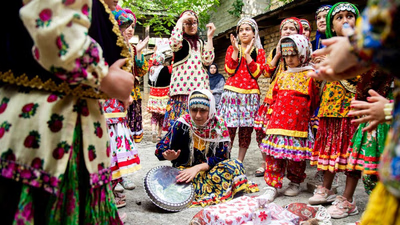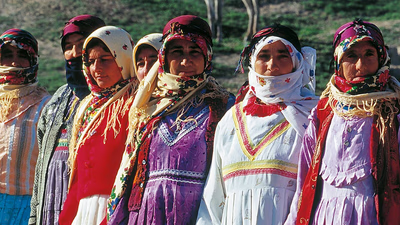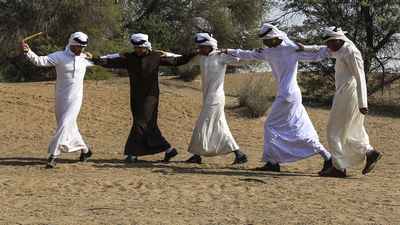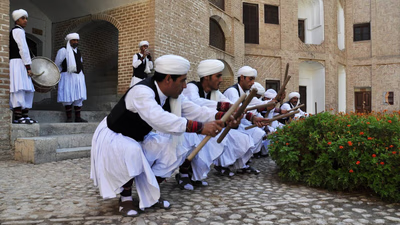
Traditional clothing showcases cultural diversity in Middle East trade.
Thawb or Dashti is common as a traditional dress in Arab countries such as Saudi Arabia, Oman, Qatar and the United Arab Emirates . This dress is in the form of a long, wrap-around cloth that is placed on the body . In Saudi Arabia, men in white robes are usually worn on public days and formal occasions. Jalabiya is a men's and women's dress that is worn in Arab regions such as Egypt, Syria and Lebanon . This dress is a long and loose cover without sleeves and is usually made of soft and comfortable fabrics. Men's jalabiya is usually white and women's jalabiya is decorated with various colors and patterns such as flower designs and motifs. Abaya is a long, loose dress worn by women in Arab countries such as Saudi Arabia, the United Arab Emirates, Qatar, and Iran . This dress is usually made of light and flowing fabrics and is placed on the head and body of women. Abaya is usually used in a simple way without more ornaments or decorations. Shamiz is a traditional women's dress that is worn in Iraq and some regions of other Arab countries such as Saudi Arabia and Bahrain . This dress is a long, wrap-around shirt that reaches the knees or soles of the feet. The shirt is usually decorated with bright colors and various patterns such as flowers and motifs.
Kimono is one of the symbols of Japanese culture and is usually worn as a dress or a piece of cloth with beautiful and colorful designs. This dress has evolved over the centuries in Japan and is still used in ceremonies and special occasions. A kimono is a one-piece cloth garment traditionally made using silk fabrics. But today it may be made of other fabrics such as cotton or polyester. Kimono has a simple and three-dimensional design that is formed by cutting and sewing fabrics in the form of one piece. The kimono is one-piece and fits wide and long on the body. This dress is usually worn up to the knees or close to the legs and is closed in the front using a strap or western belt. Some kimonos have sleeves and others are sleeveless and weighted. Kimonos are usually decorated with beautiful and impressive designs and patterns. These designs can include flowers, birds, emoticons, dreams, and traditional Japanese designs. Also, various colors such as white, black, red, blue and yellow are used in kimonos, but red color is known as one of the most popular and important colors in kimonos. Kimono is not only used as everyday clothing in Japan, but also worn for special events and occasions such as weddings, Japanese tea ceremonies, festivals and theater. This dress is designed as an important element in preserving Japanese culture and traditions, as well as a symbol of beauty and elegance.
Saree is a traditional Indian dress worn by women all over India both daily and on special occasions. Sarees are known for their beautiful and versatile designs and color combinations. A sari is a one-piece dress made of a long piece of cloth that can be twisted and twisted. The length of the saree is usually between 5 and 9 meters and its width varies from about 1 meter to 1.5 meters. The fabric used in the saree is usually silk, cotton, unisex, georgette, and various patterns that are used depending on the type of saree. Sari is used to cover the body of women and is placed on the body in a special and beautiful way. At first, the sari was wrapped as a rectangular cloth on the body and a part of it was hung on the back of the body as a pallu. But today, modern sarees consist of a part called patel (pallu) that forms a large part of the saree and a part called plate that is twisted around the waist. Sarees are decorated with various designs and patterns. These designs can include flowers, birds, geometric compositions, and traditional Indian motifs. Also, various colors such as red, gray, yellow, green, blue and purple are used in sarees.
A kilt is a traditional Scottish men's garment made from a draped fabric wrapped around a shirt. This traditional dress is known as a symbol of Scottish culture and identity. It was originally worn by men in Scotland, but is also worn by some women today. The Scottish kilt is known for its distinctive and colorful designs and some Scottish patterns and symbols used in it. A Scottish kilt is a piece of clothing made from a fabric called tartan. Tartan is a type of fabric with linear and square patterns, usually made of wool or cotton. Tartan originally comes in many colors and patterns, but the basic dyes include white, red, blue, green, and yellow. Scottish kilt is a long and wide cloth that is wrapped around the body and closed with the help of lace and cashmere. The kilt is usually knee-length or higher and hangs over the legs. One of the important features of the Scottish kilt is the presence of a toucan (pan) that is placed in the front part of the kilt and in the form of a beautiful smiley containing various symbols such as flowers, animals, motifs and Scottish national symbols.
Kimonche is a traditional Korean dress made of white cotton fabric. This dress is worn as a blouse and a long skirt and is decorated with special designs and details. Dirndl is a traditional Turkish women's dress made of soft and delicate fabric. This dress is decorated with beautiful designs and colors and hand textures. Poncho is a traditional Mexican clothing used in tropical areas. This garment is usually made of soft and colorful fabric and is used to protect against sun and wind. Liderhosen or Norwegian riding is a traditional men's clothing worn on special occasions and events. The outfit consists of a suit and a white undergarment and is completed with traditional Norwegian designs and decorations. Chanos is a traditional Greek women's dress made of soft and colorful fabric. It consists of a long inner garment and a cover over it, layered and worn on special occasions. Lederhosen is a traditional German men's clothing worn in the Bavarian region. The outfit consists of a vest, shorts and long socks and is decorated with traditional German designs and details.
In Morocco, kaftan or jalaba for men and kach kabir or embroidered board for women are known as traditional clothes. These dresses are made of colorful fabrics and decorative fabrics with geometric patterns. In Sudan, it is known as Tuba or Tandoori. This dress is usually made of simple fabric and dark and black colors and is worn in most areas of Sudan. In Yemen, the traditional men's clothing is called Mentu or Fitri, which is made of beautiful and decorative fabrics. Traditional Yemeni women's clothing includes a sari or a long dress made in Tungsten and silk nazkis. In Tunisia, the traditional men's clothing is known as the jabba, which is made of colorful fabrics and fabrics decorated with geometric patterns. Tunisian women also wear a traditional dress called Farkhandes and often combine it with a traditional jacket or jacket.
In Iran, shirts and pants are used as traditional men's clothing. The shirt is usually a long shirt with long sleeves and pants are also made with traditional patterns and designs. The colors and designs used in these clothes depend on the region and people's taste. In Afghanistan, shirts and pants are known as shirts and pants, which are made of various fabrics such as wool and linen. Also, traditional men's clothes called kamze and pants are worn in Tajikistan. Chador is one of the traditional women's clothes worn in Iran, Afghanistan and Tajikistan. This dress is in the form of a long cloth that is placed on the head and body of women and extends to the ground. In Iran, chador is used as a traditional women's dress in some regions such as Hormozgan and Khorasan provinces to be worn in public during the day. In Afghanistan and Tajikistan, women use chador as a traditional dress in some areas.
In Iran, skirts and coats are used as traditional women's clothing. A skirt is usually a knee- or ankle-length covering made with traditional patterns and designs. The coat is also a long shirt with long sleeves. In Afghanistan and Tajikistan, women use skirts and coats as traditional clothes, which are decorated with local patterns and designs. Crowns and ponchos are also part of the traditional clothes of these regions. In Iran, crowns are used as part of the bride's dress and in special ceremonies such as Nowruz. In Afghanistan and Tajikistan, crowns and crowns are decorative, which are used as a symbol of local social and cultural identity. In some regions of Iran, Afghanistan and Tajikistan, Jame and scarf are used as traditional women's clothing. A garment is a garment that is placed on the body and a scarf is worn on the head as a scarf. These clothes are usually made with a variety of patterns and designs, and the colors and designs used may vary from region to region.



